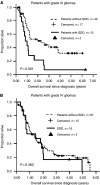Secondary dissemination in children with high-grade malignant gliomas and diffuse intrinsic pontine gliomas
- PMID: 17047647
- PMCID: PMC2360717
- DOI: 10.1038/sj.bjc.6603402
Secondary dissemination in children with high-grade malignant gliomas and diffuse intrinsic pontine gliomas
Abstract
In children, treatment regimen for high-grade gliomas (HGG) and diffuse intrinsic pontine gliomas (DIPG) are generally not stratified according to disease stage. The hypothesis was that secondary disseminating disease (SDD) in children with HGG is related to an even worse outcome. Description of SDD pattern was performed. In total, 270 children with newly diagnosed HGG or DIPG were eligible for retrospective analysis of SDD. Medical and computer records of these patients were reviewed for demographic characteristics, sites of dissemination, prognostic variables. Forty-six (17%) of the 270 patients had developed SDD. The median time to SDD was 8.2 months. The median overall survival (OS) after dissemination was 3.2 months. The SDD was located parenchymal in the supratentorial (34.8%), infratentorial (6.5%), supratentorial and infratentorial (19.6%), spinal (10.9%), spinal and cerebral (6.5%) regions of the CNS, or leptomeningeal (21.7%). For HGG patients, the median OS was shorter among patients with SDD than among patients without SDD (1.02 vs 1.41 years, P=0.0495). In the group of patients with SDD, patients with cerebrospinal fluid dissemination had a worse outcome compared with patients with parenchymal metastases. Summarising, SDD is a negative prognostic factor for patients with HGG outside the pons. Treatment stratification should be considered.
Figures
Similar articles
-
Primary dissemination of high-grade gliomas in children: experiences from four studies of the Pediatric Oncology and Hematology Society of the German Language Group (GPOH).J Neurooncol. 2005 Apr;72(2):179-83. doi: 10.1007/s11060-004-3546-5. J Neurooncol. 2005. PMID: 15925999 Clinical Trial.
-
Pseudoprogression in children, adolescents and young adults with non-brainstem high grade glioma and diffuse intrinsic pontine glioma.J Neurooncol. 2016 Aug;129(1):109-21. doi: 10.1007/s11060-016-2151-8. Epub 2016 May 14. J Neurooncol. 2016. PMID: 27180091
-
A pilot study of bevacizumab-based therapy in patients with newly diagnosed high-grade gliomas and diffuse intrinsic pontine gliomas.J Neurooncol. 2016 Mar;127(1):53-61. doi: 10.1007/s11060-015-2008-6. Epub 2015 Dec 1. J Neurooncol. 2016. PMID: 26626490
-
Pediatric glial tumors.Curr Treat Options Oncol. 2001 Dec;2(6):529-36. doi: 10.1007/s11864-001-0074-9. Curr Treat Options Oncol. 2001. PMID: 12057098 Review.
-
Pediatric high-grade gliomas and diffuse intrinsic pontine gliomas.J Child Neurol. 2009 Nov;24(11):1409-17. doi: 10.1177/0883073809338960. Epub 2009 Jul 28. J Child Neurol. 2009. PMID: 19638636 Review.
Cited by
-
Advances in Treatment of Diffuse Midline Gliomas.Curr Neurol Neurosci Rep. 2023 Dec;23(12):849-856. doi: 10.1007/s11910-023-01317-8. Epub 2023 Nov 3. Curr Neurol Neurosci Rep. 2023. PMID: 37921944 Review.
-
Pediatric diffuse intrinsic pontine glioma: can optimism replace pessimism?CNS Oncol. 2012 Nov;1(2):137-48. doi: 10.2217/cns.12.15. CNS Oncol. 2012. PMID: 25057864 Free PMC article. Review.
-
Preclinical and clinical investigation of intratumoral chemotherapy pharmacokinetics in DIPG using gemcitabine.Neurooncol Adv. 2020 Feb 24;2(1):vdaa021. doi: 10.1093/noajnl/vdaa021. eCollection 2020 Jan-Dec. Neurooncol Adv. 2020. PMID: 32642682 Free PMC article.
-
Diffuse midline glioma invasion and metastasis rely on cell-autonomous signaling.Neuro Oncol. 2024 Mar 4;26(3):553-568. doi: 10.1093/neuonc/noad161. Neuro Oncol. 2024. PMID: 37702430 Free PMC article.
-
How ten-years of reirradiation for paediatric high-grade glioma may shed light on first line treatment.J Neurooncol. 2022 Sep;159(2):437-445. doi: 10.1007/s11060-022-04079-4. Epub 2022 Jul 9. J Neurooncol. 2022. PMID: 35809148
References
-
- Allen J, Siffert J, Donahue B, Nirenberg A, Jakacki R, Robertson P, DaRosso R, Thoron L, Rosovsky M, Pinto R (1999) A phase I/II study of carboplatin combined with hyperfractionated radiotherapy for brainstem gliomas. Cancer 86: 1064–1069 - PubMed
-
- Arita N, Taneda M, Hayakawa T (1994) Leptomeningeal dissemination of malignant gliomas. Incidence, diagnosis and outcome. Acta Neurochir (Wien) 126: 84–92 - PubMed
-
- Awad I, Bay JW, Rogers L (1986) Leptomeningeal metastasis from supratentorial malignant gliomas. Neurosurgery 19: 247–251 - PubMed
-
- Benesch M, Wagner S, Berthold F, Wolff JEA (2005) Primary dissemination of high-grade gliomas in children: experiences from four studies of the Pediatric Oncology and Hematology Society of the German Language Group (GPOH). J Neurooncol 72: 179–183 - PubMed
-
- Donahue B, Allen J, Siffert J, Rosovsky M, Pinto R (1998) Patterns of recurrence in brain stem gliomas: evidence for craniospinal dissemination. Int I Radiat Oncol Biol Phys 40: 670–680 - PubMed
Publication types
MeSH terms
Substances
LinkOut - more resources
Full Text Sources
Medical



